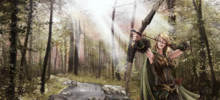- Elf
-
This article is about the mythical creature. For other uses, see Elf (disambiguation).
An elf (plural elves) is a being of Germanic mythology. The elves were originally thought of as a race of divine beings (wights, vættir) endowed with magical powers, which they use both for the benefit and the injury of mankind. In medieval Norse mythology, they appear to have been divided into light elves and dark elves, difficult to delineate from the Æsir (gods) on one hand and the dvergar (dwarves) on the other.
In early modern and modern folklore, they become associated with the fairies of Romance folklore and assume a diminutive size, often living mainly in forests but also underground in hills or rocks, or in wells and springs. 19th-century Romanticism attempted to restore them to full stature, making them men and women of great beauty, often depicted as very young.
From their depiction in Romanticism, elves entered the 20th-century high fantasy genre in the wake of the published work of J. R. R. Tolkien (especially the posthumous publication of his Silmarillion where Tolkien's treatment of the relation of light elves, dark elves and dwarves is made explicit).
The "Christmas elves" of contemporary popular culture were popularized during the 1870s in the United States, in publications such as Godey's Lady's Book.
Contents
Name
The English word elf is from the Old English ælf or elf, in reference to a midget, themselves from the Proto-Germanic *albiz which also resulted in Old Norse álfr, Middle High German elbe. *Albiz may be from the Proto-Indo-European root *albh- meaning "white", from which also stems the Latin albus "white".[1] Alternatively, a connection to the Rbhus, semi-divine craftsmen in Indian mythology, has also been suggested(OED).
Originally ælf/elf and its plural ælfe were the masculine forms, while the corresponding feminine form (first found in eighth century glosses) was ælfen or elfen (with a possible feminine plural -ælfa, found in dunælfa) which became the Middle English elven, using the feminine suffix -en from the earlier -inn which derives from the Proto-Germanic *-innja). The fact that cognates exist (such as the German elbinne) could suggest a West Germanic *alb(i)innjo, but this is uncertain, as the examples may be simply a transference to the weak declension common in Southern and Western forms of Middle English. The Middle English forms with this weak declension were aluen(e) and eluen(e). By the earlier eleventh century ælf could denote a female.
The Modern German Elf (m), Elfe (f), Elfen is a loan from English. A masculine Elb is reconstructed from the plural by Jacob Grimm, Deutsches Wörterbuch, who rejects Elfe as a (then, in the 1830s) recent anglicism. Elb (m, plural Elbe or Elben) is a reconstructed term, while Elbe (f) is attested in Middle High German. Alb, Alp (m), plural Alpe has the meaning of "incubus" (Old High German alp, plural *alpî or *elpî). Gothic has no direct testimony of *albs, plural *albeis, but Procopius has the personal name Albila.
Germanic mythology
Further information: Germanic mythologyJacob Grimm discusses "Wights and Elves" comparatively in chapter 17 of his Teutonic Mythology. He notes that the Elder Edda couples the Æsir and the álfar, a conjunction that recurs in Old English ês and ylfe, clearly grouping the elves as a divine or supernatural class of beings, sometimes extended by the Vanir as a third class: The Hrafnagaldr states Alföðr orkar, álfar skilja, vanir vita "The Allfather [i.e. the áss] has power, the álfar have skill, and vanir knowledge".
A notable crux in the Old Norse mythology is the distinction of álfar and dvergar. They appear as separate races in extended lists such as the one in Alvíssmál, listing Æsir, álfar, Vanir, goð (gods), męnn (humans), ginregin, jǫtnar, dvergar and denizens of Hęl. Middle High German tradition asgma separates the elbe from getwerc.
On the other hand, there is a close kinship between elves and dwarves, evident already because many dwarves have elvish names, including simple Álfr "elf", and Alberich "king of elves".
Loki is particularly difficult to classify; he is usually called an áss, but is really of jǫtunn origin, and is nevertheless also addressed as álfr. The conclusion of Grimm is that the classification "elf" can be considered to "shrink and stretch by turns". The etymology connecting *alboz with albus "white" suggests an original dichotomy of "white" vs. "black" genii, corresponding to the elves vs. the dwarves which was subsequently confused. Thus the "white" elves proper are named ljósálfar "light elves", contrasting with døckálfar "dark elves".
Snorri in the Prose Edda states that the light elves dwell in Álfheim while the dark elves dwell underground. Confusion arises from the introduction of the additional term svartálfar "black elves", which at first appears synonymous to the "dark elves"; Snorri identifies with the dvergar and has them reside in Svartálfaheim. This prompts Grimm to assume a tripartite division of light elves, dark elves and black elves, of which only the latter are identical with dwarves, while the dark elves are an intermediate class, "not so much downright black, as dim, dingy". In support of such an intermediate class between light elves, or "elves proper", on one hand, and black elves or dwarves on the other, Grimm adduces the evidence of the Scottish brownies and other traditions of dwarves wearing grey or brown clothing.
Old Norse
 The god Frey, the lord of the light-elves
The god Frey, the lord of the light-elves
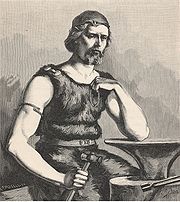 The hero Völundr the 'ruler of the elves' (vísi álfar), sometimes thought to be dwarves, nicknamed 'dark elves' (dökkálfar)
The hero Völundr the 'ruler of the elves' (vísi álfar), sometimes thought to be dwarves, nicknamed 'dark elves' (dökkálfar)
The earliest preserved descriptions of elves comes from Norse mythology. In Old Norse they are called álfar (nominative singular álfr).
Men could be elevated to the rank of elves after death, such as the petty king Olaf Geirstad-Elf. The smith hero Völundr is identified as 'Ruler of Elves' (vísi álfa) and 'One among the Elven Folk' (álfa ljóði), in the poem Völundarkviða, whose later prose introduction also identifies him as the son of a king of 'Finnar', an Arctic people respected for their shamanic magic (most likely, the sami). In the Thidrek's Saga a human queen is surprised to learn that the lover who has made her pregnant is an elf and not a man. In the saga of Hrolf Kraki a king named Helgi rapes and impregnates an elf-woman clad in silk who is the most beautiful woman he has ever seen.
Crossbreeding was possible between elves and humans in the Old Norse belief. The human queen who had an elvish lover bore the hero Högni, and the elf-woman who was raped by Helgi bore Skuld, who married Hjörvard, Hrólfr Kraki's killer. The saga of Hrolf Kraki adds that since Skuld was half-elven, she was very skilled in witchcraft (seiðr), and this to the point that she was almost invincible in battle. When her warriors fell, she made them rise again to continue fighting. The only way to defeat her was to capture her before she could summon her armies, which included elvish warriors.[2]
They are also found in the Heimskringla and in The Saga of Thorstein, Viking's Son accounts of a line of local kings who ruled over Álfheim, and since they had elven blood they were said to be more beautiful than most men.
- The land governed by King Alf was called Alfheim, and all his offspring are related to the elves. They were fairer than any other people...[3]
In addition to these human aspects, they are commonly described as semi-divine beings associated with fertility and the cult of the ancestors and ancestor worship. The notion of elves thus appears similar to the animistic belief in spirits of nature and of the deceased, common to nearly all human religions; this is also true for the Old Norse belief in dísir, fylgjur and vörðar ("follower" and "warden" spirits, respectively). Like spirits, the elves were not bound by physical limitations and could pass through walls and doors in the manner of ghosts, which happens in Norna-Gests þáttr.
The Icelandic mythographer and historian Snorri Sturluson referred to dwarves (dvergar) as "dark-elves" (dökkálfar) or "black-elves" (svartálfar). He referred to other elves as "light-elves" (ljósálfar), which has often been associated with elves' connection with Freyr, the god of fertility (according to Grímnismál, Poetic Edda). Snorri describes the elf differences as follows:
- "There is one place there that is called the Elf Home (Álfheimr which is the elven city). People live there that are named the light elves (Ljósálfar). But the dark elves (Dökkálfar) live below in earth,in caves and the dark forest and they are unlike them in appearance – and more unlike them in reality. The Light Elves are brighter than the sun in appearance, but the Dark Elves are blacker than pitch." (Snorri, Gylfaginning 17, Prose Edda)
- "Sá er einn staðr þar, er kallaðr er Álfheimr. Þar byggvir fólk þat, er Ljósálfar heita, en Dökkálfar búa niðri í jörðu, ok eru þeir ólíkir þeim sýnum ok miklu ólíkari reyndum. Ljósálfar eru fegri en sól sýnum, en Dökkálfar eru svartari en bik."[4]
Further evidence for elves in Norse mythology comes from Skaldic poetry, the Poetic Edda and legendary sagas. In these elves are linked to the Æsir, particularly by the common phrase "Æsir and the elves". In the Alvíssmál ("The Sayings of All-Wise"), elves are considered distinct from both the Æsir and the Vanir.
Grímnismál relates that the Van Frey was the lord of Álfheimr (meaning "elf-world"), the home of the light-elves. Lokasenna relates that a large group of Æsir and elves had assembled at Ægir's court for a banquet.
A poem from around 1020, the Austrfaravísur ('Eastern-journey verses') of Sigvat Thordarson, mentions that, as a Christian, he was refused board in a heathen household, in Sweden, because an álfablót ("elves' sacrifice") was being conducted there.
From the time of year (close to the autumnal equinox) and the elves' association with fertility and the ancestors, it might be assumed that it had to do with the ancestor cult and the life force of the family.
In addition to this, Kormáks saga accounts for how a sacrifice to elves was apparently believed able to heal a severe battle wound:
- Þorvarð healed but slowly; and when he could get on his feet he went to see Þorðís, and asked her what was best to help his healing.
- "A hill there is," answered she, "not far away from here, where elves have their haunt. Now get you the bull that Kormák killed, and redden the outer side of the hill with its blood, and make a feast for the elves with its flesh. Then thou wilt be healed."[5]
Old English
The Old English form of the word is ælf (pl. ælfe, with regional and chronological variants such as ylfe and ælfen). Words for the nymphs of the Greek and Roman mythos were translated by Anglo-Saxon scholars with ælf and variants on it.[6]
Old English tradition preserves the ylfe exclusively as mischievous, harmful beings. The 10th century Metrical Charm "Against A Sudden Stitch" (Wið færstice) offers remedy against sudden pain (such as rheumatism) caused by projectiles of either ése or ylfe or witches (gif hit wære esa gescot oððe hit wære ylfa gescot oððe hit wære hægtessan gescot "be it Ése-shot or Elf-shot or witch-shot").
In relation the beauty of the Norse elves, some further evidence is given by old English words such as ælfsciene ("elf-beautiful"), used of seductively beautiful Biblical women in the Old English poems Judith and Genesis A. Although elves could be considered to be beautiful and potentially helpful beings in some sections of English-speaking society throughout its history, Old English evidence also attests to alignments of elves with demons, as for example in line 112 of Beowulf. On the other hand, oaf is simply a variant of the word elf, presumably originally referring to a changeling or to someone stupefied by elvish enchantment.
Elf-shot (or elf-bolt or elf-arrow) is a word found in Scotland and Northern England, first attested in a manuscript of about the last quarter of the 16th century. Although first attested in the sense 'sharp pain caused by elves', it is later attested denoting Neolithic flint arrow-heads, which by the 17th century seem to have been attributed in the region to elvish folk, and which were used in healing rituals, and alleged to be used by witches (and perhaps elves) to injure people and cattle.[7] So too a tangle in the hair was called an elf-lock, as being caused by the mischief of the elves (or especially by Queen Mab),[8] and sudden paralysis was sometimes attributed to elf-stroke. Compare with the following excerpt from an 1750 ode by Willam Collins:
- There every herd, by sad experience, knows
- How, winged with fate, their elf-shot arrows fly,
- When the sick ewe her summer food forgoes,
- Or, stretched on earth, the heart-smit heifers lie.[9]
German
Very little material concerning elves or elben survives in Old High German beyond the mere noun form alp, plural alpî, elpî. Middle High German has a feminine singular elbe and a plural elbe, elber,[10] but the word becomes very rare, mostly surviving in the adjective elbisch, and is replaced by the English form elf, elfen via 18th century German translations of Shakespeare's A Midsummernight's Dream. The masculine alp survives in German with a shifted meaning of "nightmare".
Jacob Grimm in his Deutsches Wörterbuch deplored the "unhochdeutsch" form Elf, borrowed "unthinkingly" from the English, and Tolkien was inspired by Grimm to recommend reviving the genuinely German form in his Guide to the Names in The Lord of the Rings (1967) and Elb, Elben was consequently reintroduced in the 1972 German translation of The Lord of the Rings.
In Christian folklore, the elber began to be described as mischievous pranksters that could cause disease to cattle and people, and bring bad dreams to sleepers. The German word for nightmare, Alptraum, means "elf dream". The archaic form Alpdruck means "elf pressure"; it was believed that nightmares are a result of an elf sitting on the dreamer's chest (incubi). This aspect of German elf-belief largely corresponds to the Scandinavian belief in the mara.
Modern folklore
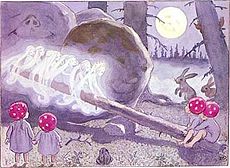 Little älvor, playing with Tomtebobarnen. From Children of the Forest (1910) by Swedish author and illustrator Elsa Beskow.
Little älvor, playing with Tomtebobarnen. From Children of the Forest (1910) by Swedish author and illustrator Elsa Beskow.
In Scandinavian folklore, which is a later blend of Norse mythology and elements of Christian mythology, an elf is called elver in Danish, alv in Norwegian, and alv or älva in Swedish (the first is masculine, the second feminine). The Norwegian expressions seldom appear in genuine folklore, and when they do, they are always used synonymous to huldrefolk or vetter, a category of earth-dwelling beings generally held to be more related to Norse dwarves than elves which is comparable to the Icelandic huldufólk (hidden people).
In Denmark and Sweden, the elves appear as beings distinct from the vetter, even though the border between them is diffuse. The insect-winged fairies in British folklore are often called "älvor" in modern Swedish or "alfer" in Danish, although the correct translation is "feer". In a similar vein, the alf found in the fairy tale The Elf of the Rose by Danish author H. C. Andersen is so tiny that he can have a rose blossom for home, and has "wings that reached from his shoulders to his feet". Yet, Andersen also wrote about elvere in The Elfin Hill. The elves in this story are more alike those of traditional Danish folklore, who were beautiful females, living in hills and boulders, capable of dancing a man to death. Like the huldra in Norway and Sweden, they are hollow when seen from the back.
 The "Elf cross" which protected against malevolent elves.[11]
The "Elf cross" which protected against malevolent elves.[11]
The elves of Norse mythology have survived into folklore mainly as females, living in hills and mounds of stones.[12] The Swedish älvor.[13] (sing. älva) were stunningly beautiful girls who lived in the forest with an elven king. They were long-lived and light-hearted in nature. The elves are typically pictured as fair-haired, white-clad, and (like most creatures in the Scandinavian folklore) nasty when offended. In the stories, they often play the role of disease-spirits. The most common, though also most harmless case was various irritating skin rashes, which were called älvablåst (elven blow) and could be cured by a forceful counter-blow (a handy pair of bellows was most useful for this purpose). Skålgropar, a particular kind of petroglyph found in Scandinavia, were known in older times as älvkvarnar (elven mills), pointing to their believed usage. One could appease the elves by offering them a treat (preferably butter) placed into an elven mill – perhaps a custom with roots in the Old Norse álfablót.
In order to protect themselves against malevolent elves, Scandinavians could use a so-called Elf cross (Alfkors, Älvkors or Ellakors), which was carved into buildings or other objects.[11] It existed in two shapes, one was a pentagram and it was still frequently used in early 20th century Sweden as painted or carved onto doors, walls and household utensils in order to protect against elves.[11] As the name suggests, the elves were perceived as a potential danger against people and livestock.[11] The second form was an ordinary cross carved onto a round or oblong silver plate.[11] This second kind of elf cross one was worn as a pendant in a necklace and in order to have sufficient magic it had to be forged during three evenings with silver from nine different sources of inherited silver.[11] In some locations it also had to be on the altar of a church during three consecutive Sundays.[11]
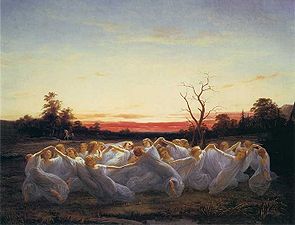 Ängsälvor, "meadow elves", (1850), painting by Nils Blommér.
Ängsälvor, "meadow elves", (1850), painting by Nils Blommér.
 Älvalek, "Elf Play", (1866), painting by August Malmström.
Älvalek, "Elf Play", (1866), painting by August Malmström.
The elves could be seen dancing over meadows, particularly at night and on misty mornings. They left a kind of circle where they had danced, which were called älvdanser (elf dances) or älvringar (elf circles), and to urinate in one was thought to cause venereal diseases. Typically, elf circles were fairy rings consisting of a ring of small mushrooms, but there was also another kind of elf circle:
- On lake shores, where the forest met the lake, you could find elf circles. They were round places where the grass had been flattened like a floor. Elves had danced there. By Lake Tisaren,[14] I have seen one of those. It could be dangerous and one could become ill if one had trodden over such a place or if one destroyed anything there.[12]
If a human watched the dance of the elves, he would discover that even though only a few hours seemed to have passed, many years had passed in the real world. (This time phenomenon is retold in Tolkien's The Lord of the Rings when the Fellowship pass into both Rivendell and Lothlórien, where time seems almost to stand still. It also has a remote parallel in the Irish sídhe.) In a song from the late Middle Ages about Olaf Liljekrans, the elven queen invites him to dance. He refuses, he knows what will happen if he joins the dance and he is on his way home to his own wedding. The queen offers him gifts, but he declines. She threatens to kill him if he does not join, but he rides off and dies of the disease she sent upon him, and his young bride dies of a broken heart.[15]
However, the elves were not exclusively young and beautiful. In the Swedish folktale Little Rosa and Long Leda, an elvish woman (älvakvinna) arrives in the end and saves the heroine, Little Rose, on condition that the king's cattle no longer graze on her hill. She is described as a beautiful old woman and by her aspect people saw that she belonged to the subterraneans.[16]
Icelandic
See also: huldufólkExpression of belief in huldufólk or "hidden folk", the elves that dwell in rock formations, is common in Iceland. If the natives do not explicitly express their belief, they are often reluctant to express disbelief.[17] A 2006 and 2007 study on superstition by the University of Iceland’s Faculty of Social Sciences supervised by Terry Gunnell (associate folklore professor), reveal that natives would not rule out the existence of elves and ghosts (similar results of a 1974 survey by Professor Erlendur Haraldsson, Fréttabladid reports). Gunnell stated: "Icelanders seem much more open to phenomena like dreaming the future, forebodings, ghosts and elves than other nations." His results were consistent with a similar study conducted in 1974.[18]
German
An elven king occasionally appears among the predominantly female elves as in Denmark and Sweden. In the German middle-age epic the Nibelungenlied, a dwarf named Alberich plays an important role. Alberich literally translates as "elf-sovereign", further contributing to the elf–dwarf confusion observed already in the Younger Edda. Via the French Alberon, the same name has entered English as Oberon – king of elves and fairies in Shakespeare's A Midsummer Night's Dream (see below).
The legend of Der Erlkönig appears to have originated in fairly recent times in Denmark and Goethe based his poem on "Erlkönigs Tochter" ("Erlkönig's Daughter"), a Danish work translated into German by Johann Gottfried Herder.
The Erlkönig's nature has been the subject of some debate. The name translates literally from the German as "Alder King" rather than its common English translation, "Elf King" (which would be rendered as Elfenkönig in German). It has often been suggested that Erlkönig is a mistranslation from the original Danish ellerkonge or elverkonge, which does mean "elf king".
According to German and Danish folklore, the Erlkönig appears as an omen of death, much like the banshee in Irish mythology. Unlike the banshee, however, the Erlkönig will appear only to the person about to die. His form and expression also tell the person what sort of death they will have: a pained expression means a painful death, a peaceful expression means a peaceful death. This aspect of the legend was immortalised by Goethe in his poem Der Erlkönig, later set to music by Schubert.
In the first story of the Brothers Grimm fairy tale Die Wichtelmänner, the title protagonists are two naked mannequins, which help a shoemaker in his work. When he rewards their work with little clothes, they are so delighted, that they run away and are never seen again. Even though Wichtelmänner are akin to beings such as kobolds, dwarves and brownies, the tale has been translated into English as The Elves and the Shoemaker, and is echoed in J. K. Rowling's Harry Potter stories (see House-elf).
Variations of the German elf in folklore include the moss people[19] and the weisse frauen ("white women"). On the latter Jacob Grimm does not make a direct association to the elves, but other researchers see a possible connection to the shining light elves of Old Norse.[20]
English and Lowland Scottish
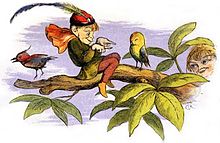 Poor little birdie teased, by Victorian era illustrator Richard Doyle depicts the traditional view of an elf from later English folklore as a diminutive woodland humanoid.
Poor little birdie teased, by Victorian era illustrator Richard Doyle depicts the traditional view of an elf from later English folklore as a diminutive woodland humanoid.
The elf makes many appearances in ballads of English and Scottish origin, as well as folk tales, many involving trips to Elphame or Elfland (the Álfheim of Norse mythology), a mystical realm which is sometimes an eerie and unpleasant place. The elf is occasionally portrayed in a positive light, such as the Queen of Elphame in the ballad Thomas the Rhymer, but many examples exist of elves of sinister character, frequently bent on rape[citation needed] and murder, as in the Tale of Childe Rowland, or the ballad Lady Isabel and the Elf-Knight, in which the Elf-Knight bears away Isabel to murder her. Most instances of elves in ballads are male; the only commonly encountered female elf is the Queen of Elfland, who appears in Thomas the Rhymer and The Queen of Elfland's Nourice, in which a woman is abducted to be a wet-nurse to the queen's baby, but promised that she may return home once the child is weaned. In none of these cases is the elf a spritely character with pixie-like qualities.
English folktales of the early modern period commonly portray elves as small, elusive people with mischievous personalities. They are often portrayed as children with Williams syndrome (which was not recognised as a medical condition but some specialist believe that people were enchanted with their character and appearance that they believed to be magical),[21] usually with fair hair. They are not evil but might annoy humans or interfere in their affairs. They are sometimes said to be invisible. In this tradition, elves became similar to the concept of fairies. As people from the English countryside immigrated to America, they brought elements of English folklore with them, and this particular depiction of elves then evolved in America into the Christmas elves of pop culture.[citation needed]
Successively, the word elf, as well as literary term fairy, evolved to a general denotation of various nature spirits like Puck, hobgoblins, Robin Goodfellow, the English and Scots brownie, the Northumbrian English hob and so forth. These terms, like their relatives in other European languages, are no longer clearly distinguished in popular folklore.
Significant for the distancing of the concept of elves from its mythological origins was the influence from literature. In Elizabethan England, William Shakespeare imagined elves as little people. He apparently considered elves and fairies to be the same race. In Henry IV, part 1, act II, scene iv, he has Falstaff call Prince Henry, "you starveling, you elfskin!", and in his A Midsummer Night's Dream, his elves are almost as small as insects. On the other hand, Edmund Spenser applies elf to full-sized beings in The Faerie Queene.
The influence of Shakespeare and Michael Drayton made the use of elf and fairy for very small beings the norm. In Victorian literature, elves usually appeared in illustrations as tiny men and women with pointed ears and stocking caps. An example is Andrew Lang's fairy tale Princess Nobody (1884), illustrated by Richard Doyle, where fairies are tiny people with butterfly wings, whereas elves are tiny people with red stocking caps. There were exceptions to this rule however, such as the full-sized elves who appear in Lord Dunsany's The King of Elfland's Daughter as well as Northern English and Scottish Lowlands folklore (as seen in such tales as The Queen of Elfan's Nourice and other local variants).
American Christmas Elf
Main article: Christmas elfIn the United States, Canada, the United Kingdom, and Ireland the modern children's folklore of Santa Claus typically includes elves at Christmas; green-clad elves with pointy ears, long noses, and pointy hats as Santa's helpers or hired workers. They make the toys in a workshop located in the North Pole. In this portrayal, elves slightly resemble nimble and delicate versions of the dwarves of Norse mythology as well as the elves in English folktakes in the Victorian period from which they could have derived.
The vision of the small but crafty Christmas elf (possibly derived from the elves of English fairytales of the Victorian period) has come to influence modern popular conception of elves, and sits side by side with the fantasy elves following Tolkien's work (see below). The American cookie company Keebler has long advertised that its cookies are made by elves in a hollow tree, and Kellogg's, who happens to now be the owner of Keebler, uses the elves of Snap, Crackle, and Pop as mascots of Rice Krispies cereal, and the role of elves as Santa's helpers has continued to be popular, as evidenced by the success of the popular Christmas movie Elf. It should be noted that these elves are referred to as elfish or elfin as opposed to elven[citation needed].
Fantasy fiction
Main article: Elves in fantasy fiction and gamesThe fantasy genre in the 20th century grows out of 19th century Romanticism. 19th century scholars such as Andrew Lang and the Grimm brothers collected "fairy-stories" from popular folklore and in some cases retold them freely. A pioneering work of the genre that would come to be known as "fantasy" was The King of Elfland's Daughter, a 1924 novel by Lord Dunsany. The Hobbit by J. R. R. Tolkien (1937) is seminal, predating the lecture On Fairy-Stories by the same author by a few years. In the 1939 lecture, Tolkien introduced the term "Fantasy" in a sense of "higher form of Art, indeed the most nearly pure form, and so (when achieved) the most potent". Elves played a central role in Tolkien's legendarium, notably The Silmarillion. Tolkien's writing has such popularity that in the 1960s and afterwards, Elves speaking an Elvish language similar to those in Tolkien's novels (like Quenya, and Sindarin) became staple non-human characters in high fantasy works and in fantasy role-playing games.
Post-Tolkien fantasy elves (popularized by the Dungeons & Dragons role-playing game) tend to be more beautiful and wiser than humans, with sharper senses and perceptions. They are said to be gifted in magic and mentally sharp and are characterized as lovers of nature, art, and song. Often, they are skilled archers. A hallmark of fantasy elves is their long and pointed ears (a convention begun with a note of Tolkien's that the ears of elves were "leaf-shaped").[22]
Film
- Marianne
- The Lord of the Rings Trilogy
- The Troll Hunter
References
- ^ IE root *albh-, in American Heritage Dictionary of the English Language 2000. bartleby.com
- ^ Setr Skuld hér til inn mesta seið at vinna Hrólf konung, bróður sinn, svá at í fylgd er með henni álfar ok nornir ok annat ótöluligt illþýði, svá at mannlig náttúra má eigi slíkt standast.[1]
- ^ The Saga of Thorstein, Viking's Son[dead link] (Old Norse original: Þorsteins saga Víkingssonar). Chapter 1.
- ^ Sturluson, Snorri. The Younger (or Prose) Edda, Rasmus B. Anderson translation (1897). Chapter 7.
- ^ The Life and Death of Cormac the Skald (Old Norse original: Kormáks saga). Chapter 22.
- ^ OED
- ^ Hall, Alaric. 2005. 'Getting Shot of Elves: Healing, Witchcraft and Fairies in the Scottish Witchcraft Trials', Folklore, 116 (2005), 19-36.
- ^ "elf-lock", OED Online (Oxford University Press), 1989, http://dictionary.oed.com/cgi/entry/50073178, retrieved 26 November 2009
- ^ Collins, Willam. 1775. An Ode On The Popular Superstitions Of The Highlands Of Scotland, Considered As The Subject Of Poetry.
- ^ Marshall Jones Company (1930). Mythology of All Races Series, Volume 2 Eddic, Great Britain: Marshall Jones Company, 1930, pp. 220.
- ^ a b c d e f g The article Alfkors in Nordisk familjebok (1904).
- ^ a b An account given in 1926, Hellström (1990). En Krönika om Åsbro. pp. 36. ISBN 91-7194-726-4.
- ^ For the Swedish belief in älvor see mainly Schön, Ebbe (1986). "De fagra flickorna på ängen". Älvor, vättar och andra väsen. ISBN 91-29-57688-1. A more summary description in English is provided by Keightley, Thomas (1870). The Fairy Mythology. http://www.sacred-texts.com/neu/celt/tfm/., esp. chapter Scandinavia: Elves.
- ^ Google Maps
- ^ Keightley, Thomas (1870). The Fairy Mythology. http://www.sacred-texts.com/neu/celt/tfm/. provides two translated versions of the song: Sir Olof in Elve-Dance and The Elf-Woman and Sir Olof.
- ^ "Lilla Rosa och Långa Leda". Svenska folksagor. Stockholm: Almquist & Wiksell Förlag AB. 1984. pp. 158.
- ^ Novatoadvance.com, Chasing waterfalls ... and elves
- ^ Icelandreview.com, Iceland Still Believes in Elves and Ghosts
- ^ Thistelton-Dyer, T.F. The Folk-lore of Plants, 1889. Available online by Project Gutenberg. File retrieved 3-05-07.
- ^ Grimm, Jacob (1835). Deutsche Mythologie (German Mythology); From English released version Grimm's Teutonic Mythology (1888); Available online by Northvegr © 2004-2007, Chapter 32, pages 2,3; Marshall Jones Company (1930). Mythology of All Races Series, Volume 2 Eddic, Great Britain: Marshall Jones Company, 1930, pp. 221-222.
- ^ Books.google.co.uk
- ^ Tolkien, J.R.R., Letter #27 (writing to Houghton-Mifflin circa March–April 1938.) http://tolkien.slimy.com/essays/Ears.html
- Jacob Grimm, Teutonic Mythology (1835).
- Marshall Jones Company (1930). Mythology of All Races Series, Volume 2 Eddic, Great Britain: Marshall Jones Company, 1930, 220-221.
- Jolly, Karen Louise. Popular Religion in Late Saxon England: Elf Charms in Context. Chapel Hill, University of North Carolina Press, 1996.
- Coghlan, Ronan. Handbook of Fairies, Milverton, Capall Bann, 2002.
External links
- Wikisource:Prose Edda/Gylfaginning (The Fooling Of Gylfe) by Sturluson, Snorri, 13th century Edda, in English. Accessed Apr. 16, 2007
- Anderson, H. C.. 1842. The Elf of the Rose (Danish original: Rosen-Alfen).
- Anderson, H. C. 1845. The Elfin Hill (Danish original: Elverhøi).
Elves Germanic mythology
and Germanic paganismCategories (Dökkálfar and Ljósálfar · Half-elf · Svartálfar) · Figures associated with (Freyr · Völundr) · Locations (Álfheimr · Svartálfaheimr) · Religious practices (Álfablót)Modern influence See also Norse paganism Deities,
heroes,
and figuresOthersAsk and Embla · Dís (Norns · Valkyries) · Dwarf · Einherjar · Elves (Light elves · Dark elves) · Fenrir · Hel · Jörmungandr · Jötunn · Sigurd · Völundr · Vættir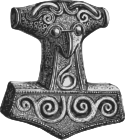
Locations Asgard · Bifröst · Fólkvangr · Ginnungagap · Hel · Jötunheimr · Midgard · Múspellsheimr · Niflheim · Valhalla · Vígríðr · Wells (Mímisbrunnr · Hvergelmir · Urðarbrunnr) · YggdrasilEvents Sources Society See also Anglo-Saxon paganism and mythology Gods and divine figures Heroic figures Other beings Locations Sources Origins Society and culture Neopagan revival Categories:- Elves
- English folklore
- English legendary creatures
- Germanic paganism
- Germanic legendary creatures
- Mythic humanoids
- Northumbrian folklore
- Northumbrian folkloric beings
Wikimedia Foundation. 2010.

